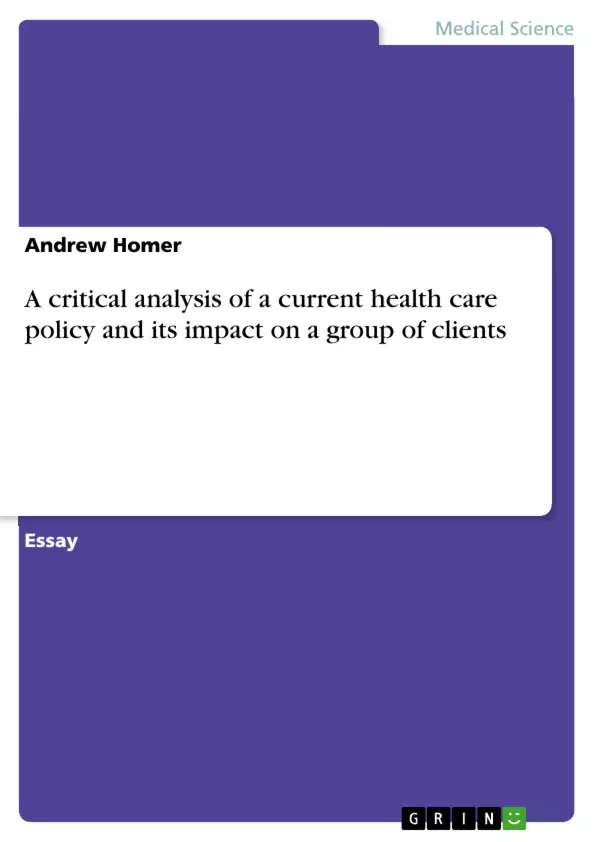The aim of this essay is to critically analyse the impact of smoke-free legislation and smoking cessation, as part of a wider anti-smoking strategy, on individuals admitted in an inpatient psychiatric setting. This will involve discussing the economic, ethical, legal and social influences that helped shape this policy as well as the physical and psychological impact on Patients. It will seek to explain how the views of patients and staff affect the implementation of this policy while discussing the effectiveness of interventions used under the policy. Some gaps in the legislation and policy will be discussed with recommendations as to how to address these and have a positive impact on the physical and mental health of patients in psychiatric settings.
Inhaltsverzeichnis (Table of Contents)
- Introduction
- The Economic, Ethical, Legal and Social Influences that Shaped the Smoke-Free Policy
- Economic Influence
- Ethical Influence
- Legal Influence
- Social Influence
- The Impact of Smoke-Free Legislation on Patients in an Inpatient Psychiatric Setting
- Physical Impact
- Psychological Impact
- The Views of Patients and Staff on the Implementation of Smoke-Free Legislation
- The Effectiveness of Interventions Used Under the Smoke-Free Policy
- Gaps in the Legislation and Policy
- Recommendations for Addressing Gaps in the Legislation and Policy
- Conclusion
Zielsetzung und Themenschwerpunkte (Objectives and Key Themes)
This essay critically analyzes the impact of smoke-free legislation and smoking cessation on individuals admitted to an inpatient psychiatric setting. It examines the economic, ethical, legal, and social factors influencing the policy's development, as well as its physical and psychological effects on patients. The essay also explores the perspectives of patients and staff on the implementation of the policy, and evaluates the effectiveness of interventions used under the policy. It concludes by discussing gaps in the legislation and policy and offering recommendations for addressing these gaps.
- The economic, ethical, legal, and social influences that shaped smoke-free legislation and smoking cessation.
- The physical and psychological impact of smoke-free legislation on patients in an inpatient psychiatric setting.
- The views of patients and staff on the implementation of smoke-free legislation.
- The effectiveness of interventions used under the smoke-free policy.
- Gaps in the legislation and policy and recommendations for addressing these gaps.
Zusammenfassung der Kapitel (Chapter Summaries)
The introduction provides an overview of the essay's aim and scope, highlighting the focus on critically analyzing the impact of smoke-free legislation on individuals in an inpatient psychiatric setting. It outlines the key areas of investigation, including the economic, ethical, legal, and social influences shaping the policy, as well as the physical and psychological impact on patients.
The second chapter delves into the economic, ethical, legal, and social influences that shaped the smoke-free policy. It discusses the significant financial burden imposed by smoking-related illnesses on the NHS and the wider economy. The chapter also explores ethical concerns raised by organizations like ASH regarding the lack of informed decision-making among smokers and the detrimental effects of secondhand smoke on non-smokers, particularly children.
The third chapter focuses on the impact of smoke-free legislation on patients in an inpatient psychiatric setting. It examines the physical and psychological consequences of smoking cessation, including the potential for increased aggression and the challenges associated with implementing a comprehensive smoking ban in mental health settings.
The fourth chapter examines the views of patients and staff on the implementation of smoke-free legislation. It presents findings from studies that suggest a significant portion of staff believe patients should have the right to smoke in designated areas and that denying this right could lead to increased aggression. The chapter also highlights the potential for staff non-compliance and the challenges of enforcing a consistent smoking policy in mental health units.
The fifth chapter analyzes the effectiveness of interventions used under the smoke-free policy. It discusses the potential benefits of smoking cessation, including increased lifespan and improved physical health. However, it also acknowledges the complexities of implementing an effective smoking ban in psychiatric settings, particularly given the prevalence of smoking among patients and the potential for staff and patients to smoke together in designated areas.
The sixth chapter explores gaps in the legislation and policy. It identifies areas where the policy is incomplete or inconsistent, such as the lack of clear guidelines for managing smoking in psychiatric settings and the potential for conflicting views on patient rights and the need to create smoke-free environments.
The seventh chapter offers recommendations for addressing gaps in the legislation and policy. It suggests that an outright ban on smoking in all healthcare settings would be more effective than a partial ban, particularly in light of the evidence suggesting that smoking cessation can improve patients' physical and mental health. It also emphasizes the importance of staff education and training to ensure compliance with the policy and to promote a smoke-free culture within mental health settings.
Schlüsselwörter (Keywords)
Smoke-free legislation, smoking cessation, inpatient psychiatric setting, economic impact, ethical influence, legal influence, social influence, patient rights, staff compliance, health policy, mental health, physical health, psychological impact, interventions, gaps in policy, recommendations, NHS, ASH, WHO, FCTC, Health Act, NMC.
- Quote paper
- Andrew Homer (Author), 2013, A critical analysis of a current health care policy and its impact on a group of clients, Munich, GRIN Verlag, https://www.grin.com/document/353857



